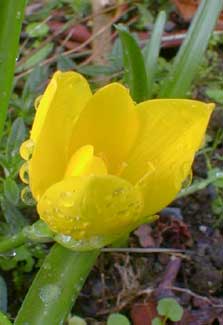
Lily of the Field; aka:
Winter Daffodil,
Autumn Narcisus, or
Golden Autumn Crocus
"I found a yellow flower in the grass,
A tiny flower with petals like a bell,
And yet, methought, more than a flower it was,--
More like a miracle."
-John Hall Ingham,
b.1860
b.1860
Athough Lily of the Field (Sternbergia lutea) is also commonly called Winter or Autumn Daffodil for its daffodil-yellow color, its flowers actually much more resemble crocuses, so that it is sometimes called Autumn Crocus. It is neither a daffodil nor a crocus, however, it is of the amaryllis family.
The photo shows an October flower, very reminiscent of a yellow crocus. It stands only about four inches tall. It has fat leaves instead of crocus grass, which begins to appear shortly after the blooms appear. The leaves last through winter & much of spring.
Sternbergia is thought to have been gardened in America since Colonial times. This native of Italy wants dryish or well-draining gravelly soil in bright afternoon sun or a very small amount of shade. In Zone 8 it may need some protection from winter winds or below-freezing weather, since it can be frost-damaged anywhere below 28 degrees F., hence is only semi-hardy on Puget Sound. It is fully hardy in zones 9 or 10.
It can naturalize & self-seed in conditions that it likes best, but on Puget Sound it may be just a little too chilly in winter & the soil too acidic for a bulbous flower that prefers its pH very slightly to the alkaline side of the scale. It can still do well on Puget Sound but may need more bulbs added to a drift every couple of years, or they will slowly vanish.
We planted a dozen Lily of the Field bulbs five inches apart & five inches deep near a 'Jean Marie' rhododendron, on a well-draining rock ledge.